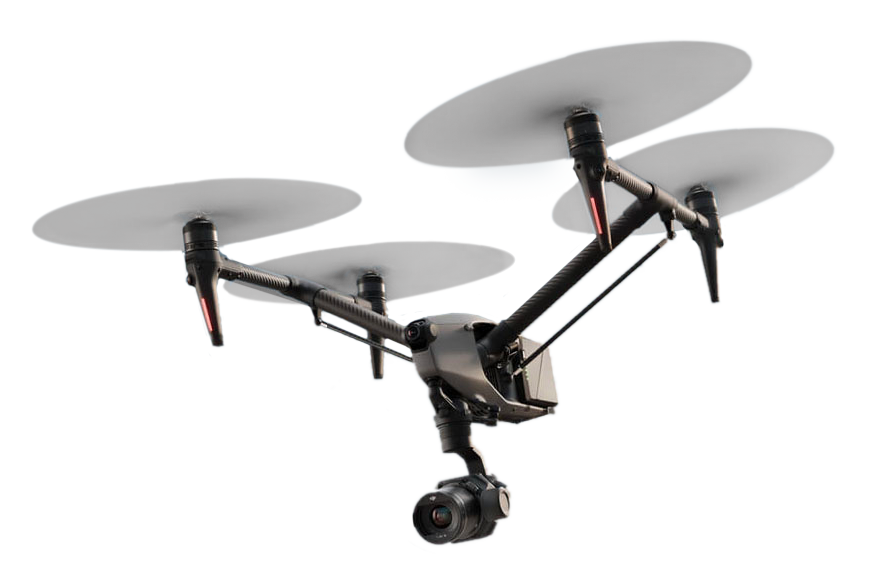Drones and camera stabilization technology changes at a furious pace. It wasn’t till 2011 when FreeFly introduced the Cinestar, then in 2013 DJI introduced the Phantom 1, suddenly you could buy a capable / pre-built UAS, and an revolution 'was launched'. Before that it was a cottage industry of custom built one offs. However, the unsung hero of multi-rotors' was the introduction of LIPO batteries which made flight possible with their ability to quickly store and release energy.. These paradigm shifts have forever changed movie making, and we’ve been involved since those early days. Our capabilities don’t stop with drones. We've added the EagleCam to our arsenal a few years ago, and are on the final step of development for a robotic car arm called ChaseJib.
The drones below are the most popular for shooting tv/ movies and content, and what we use. We believe in providing the right drone for the job and not up-selling to make more money.
Smaller drones Like the MAVIC 3 Pro are handled by one operator for budget conscious productions, but with features like 5.1K ProRes and optical zoom, this is a sweet spot for many productions.
The brand new INSPIRE 3 is a medium sized drone that offers full sized features that used to cost thousands more, and can be handled by a 1 or 2 man crew.
For an in-depth explanation about drones and what you need to know before hiring a drone, please read our blog post “Five essential questions a producer should ask a drone pilot” Or give us a call!

The mavic 3 Pro burst onto the scene mid 2023 as a small production game changer. First off there's the optical zoom. A drone with In camera zoom at this quality was unheard off till now. The wireless down-link called Ocusync 3 gives it a super stable 1080p connection with an HDMI connector on the controller. Live broadcasts, or second monitors are a snap! It boasts a Micro 4/3 sensor that records in 5.1K ProRes and LOG, with frame rates of up to 200 FPS. With its small size and low noise, it's in a category all on its own.
The Inspire 3, released in June of 2023 has caused a paradigm shift in the drone industry. Now with a form factor that's built for stability, with 27 minute flight times, we have a full frame sensor that can record up to 8k ProRes and Cinema DNG, For live streaming there's a a 4k down-link which by itself is huge. These are all expected advances when you look at the history of drones. What was a complete game changer was the RTK which stands for "Real-Time Kinetic positioning" which gives us the ability to carefully map out a complex flight path, then repeat that path with 1cm accuracy! Another very useful aspect is the pilot can throttle thru that path using the dolly function, keeping pace with the action.
The Freefly Alta X represents the latest technology from the company the pioneered flying a cinema camera on a drone. Capable of flying up to a 35lb payload this was significant boost to the industry. Up to this point there were only a few drones capable of lifting over 20lbs payload which presented a limitation as to the lens that could be flown. Now almost any lens (within reason) can be incorporated while still being able to have full FIZ control, filters, etc. The Alta X is fast, folds down to a travel friendly size, and can be set-up in minutes. It does require time to build out, so it's not plug and play

These are drones that have very specific purposes in our arsenal. If you want to get in depth see our blog post “Five essential questions a producer should ask a drone pilot part 4” Or ... just give us a call!
FPV drones are the latest "sensation" to the drone industry. Born out of the FPV racing technology its a lightweight compact frame with high powered motors that take many shapes, speeds and sizes. The operator uses "First person View (FPV)" goggles, which provide much finer accuracy to pilot. Often diving straight down. flying thru gaps, coming close to objects, or performing a trick into the action giving the viewer a up close - visceral experience. Being light and maneuverable FPV Drones can get moving shots that were impossible until recently. We offer many different FPV Models as each and every one is specific to the application.
The DJI Mini 3 & 4 are perfect for social media content, in fact the camera can be tilted at a 90º angle for stories and TikTok. The most notable features is how quiet it is. Because of its puny size it can be flown inside without disturbing those stacks of hundred dollar bills, and flown close to talent without concern since it has attachable prop guards and the low noise makes it less intimidating. Since it can be paired to the DJI Pro Controller which has an HDMI output, it can be used for streaming or for video village. While the camera is "good enough" it's still in the bush league category when it comes to anything but small.